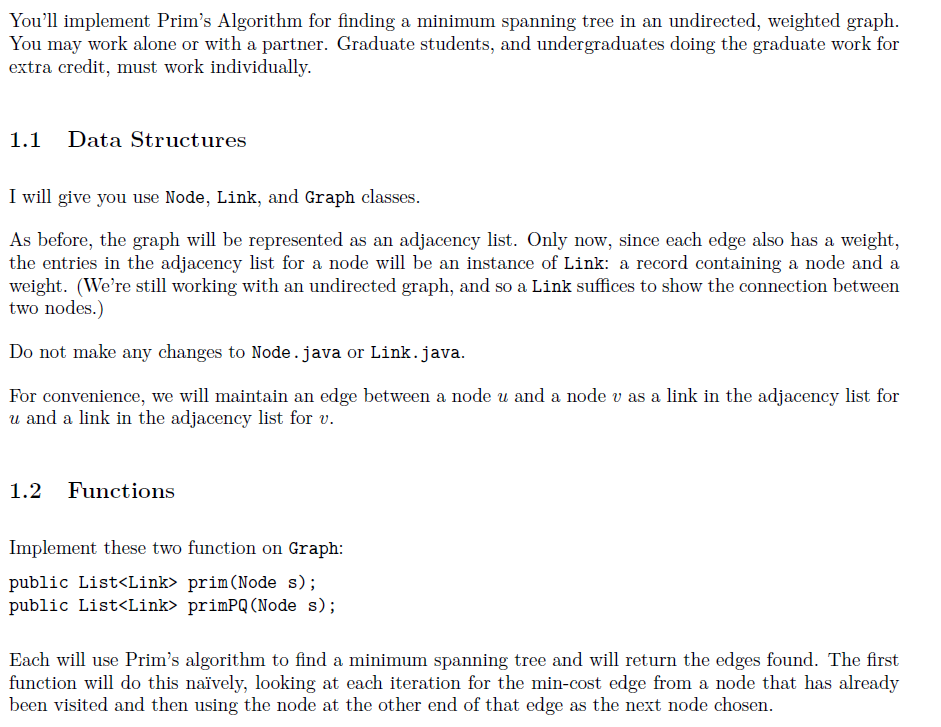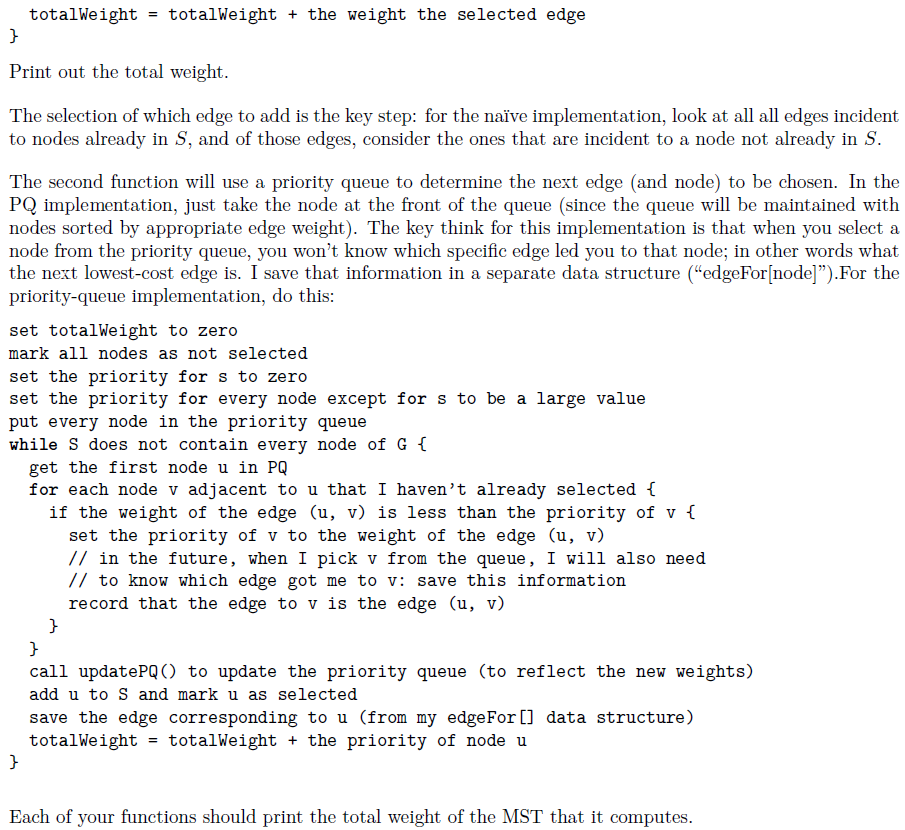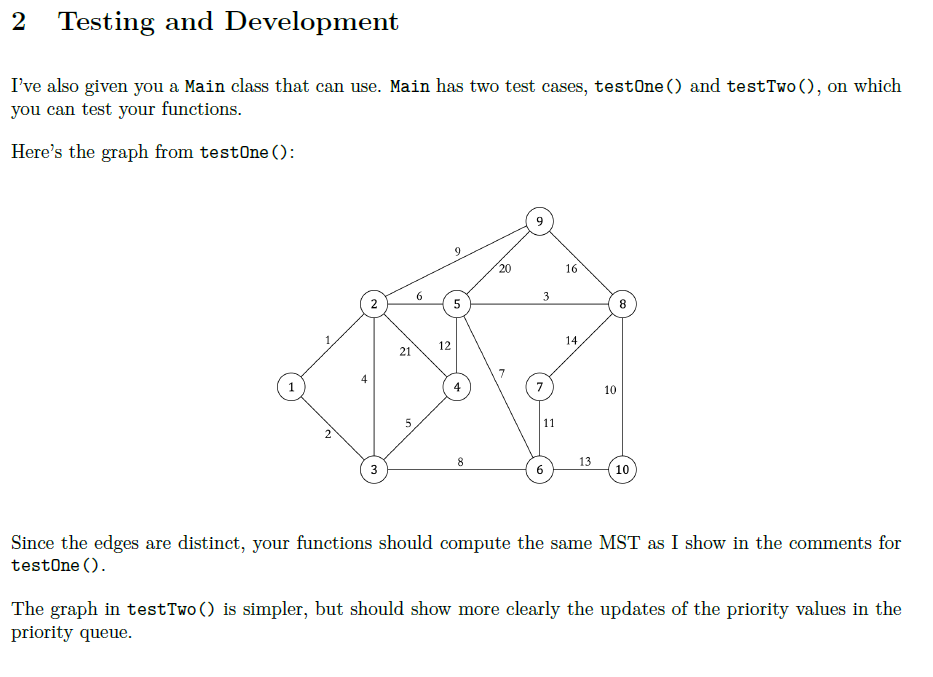Question
Please code in Java and add comments for my understanding. Instructions, Pseudo code, and Start-up code is given to implement Prim's Algorithm. Thanks! -------------------------------------------------------------------------------------------------------------------------------------------------------------------------------------------------------------------- Pseudo
Please code in Java and add comments for my understanding. Instructions, Pseudo code, and Start-up code is given to implement Prim's Algorithm. Thanks!
--------------------------------------------------------------------------------------------------------------------------------------------------------------------------------------------------------------------

Pseudo Code:




---------------------------------------------------------------------------------------- Start-up Code -----------------------------------------------------------------------------------------------------------------------------------
1) Node.Java
import java.util.List;
import java.util.ArrayList;
import java.lang.Comparable;
public class Node implements Comparable {
List
int name;
int priority; // needed for PQ implementation
public Node(int name) {
this.name = name;
this.adjlist = new ArrayList
this.priority = 0;
}
public void add(Edge edge) {
this.adjlist.add(edge);
}
// this is needed for PQ implementation
public int compareTo(Object o) {
Node otherNode = (Node) o;
if (this.priority
return -1;
else if (this.priority > otherNode.priority)
return 1;
else
return 0;
}
@Override
public String toString() {
String s = "N" + this.name;
return s;
}
} // class Node
***********************************************************************************************
2) Edge.Java
public class Edge {
int weight;
Node n1;
Node n2;
public Edge(Node n1, Node n2, int weight) {
this.n1 = n1;
this.n2 = n2;
this.weight = weight;
}
@Override
public String toString() {
String s = "(" + this.n1.name + ", " + this.n2.name + "); wt = " + this.weight;
return s;
}
// needed only for grad assignment
public int compareTo(Object o) {
Edge otherEdge = (Edge) o;
if (this.weight
return -1;
else if (this.weight > otherEdge.weight)
return 1;
else
return 0;
}
} // class Edge
****************************************************************************************
3) Graph.Java
import java.util.List;
import java.util.ArrayList;
import java.util.PriorityQueue;
public class Graph {
List
//---------------------------------------------------
public Graph() {
nodes = new ArrayList
}
//---------------------------------------------------
public void addNode(Node node) {
for (Node n: this.nodes) {
if (n == node) {
System.out.println("ERROR: graph already has a node " + n.name);
assert false;
}
}
this.nodes.add(node);
}
//---------------------------------------------------
public void addEdge(Node n1, Node n2, int weight) {
// outgoing edge
int idx1 = this.nodes.indexOf(n1);
if (idx1
System.out.println("ERROR: node " + n1.name + " not found in graph");
assert false;
}
int idx2 = this.nodes.indexOf(n2);
if (idx2
System.out.println("ERROR: node " + n2.name + " not found in graph");
assert false;
}
Edge e1 = new Edge(n1, n2, weight);
this.nodes.get(idx1).add(e1);
Edge e2 = new Edge(n2, n1, weight);
this.nodes.get(idx2).add(e2);
}
//-----------------------------------------------
public List
// implement this
} // prim()
//-----------------------------------------------
public List
// implement this
} // primPQ()
} // class Graph
*************************************************************************************************************
4) Main.Java
import java.util.List;
public class Main {
public static void main(String args[]) {
testOne();
testTwo();
}
// From the lecture slides.
// Starting at node 10, here are the edges that form an MST:
// (10, 8), (8, 5), (5, 2), (2, 1), (1, 3), (3, 4), (3, 6),
// (2, 9), (6, 7); the total weight is 54
// Your function should select nodes in this order:
// 10, 8, 5, 2, 1, 3, 4, 6, 9, 7
public static void testOne() {
System.out.println("this is testOne()");
Node n1 = new Node(1);
Node n2 = new Node(2);
Node n3 = new Node(3);
Node n4 = new Node(4);
Node n5 = new Node(5);
Node n6 = new Node(6);
Node n7 = new Node(7);
Node n8 = new Node(8);
Node n9 = new Node(9);
Node n10 = new Node(10);
Graph G = new Graph();
G.addNode(n1);
G.addNode(n2);
G.addNode(n3);
G.addNode(n4);
G.addNode(n5);
G.addNode(n6);
G.addNode(n7);
G.addNode(n8);
G.addNode(n9);
G.addNode(n10);
G.addEdge(n1, n2, 1);
G.addEdge(n1, n3, 2);
G.addEdge(n2, n3, 4);
G.addEdge(n2, n4, 21);
G.addEdge(n2, n5, 6);
G.addEdge(n2, n9, 9);
G.addEdge(n3, n4, 5);
G.addEdge(n3, n6, 8);
G.addEdge(n4, n5, 12);
G.addEdge(n5, n6, 7);
G.addEdge(n5, n8, 3);
G.addEdge(n5, n9, 20);
G.addEdge(n6, n7, 11);
G.addEdge(n6, n10, 13);
G.addEdge(n7, n8, 14);
G.addEdge(n8, n9, 16);
G.addEdge(n8, n10, 10);
System.out.println("first call prim()");
List
for (Edge e: edges)
System.out.println(e);
System.out.println();
System.out.println("now call primPQ()");
edges = G.primPQ(n10);
for (Edge e: edges)
System.out.println(e);
} // testOne()
public static void testTwo() {
System.out.println("this is testTwo()");
Node n1 = new Node(1);
Node n2 = new Node(2);
Node n3 = new Node(3);
Node n4 = new Node(4);
Node n5 = new Node(5);
Graph G = new Graph();
G.addNode(n1);
G.addNode(n2);
G.addNode(n3);
G.addNode(n4);
G.addNode(n5);
G.addEdge(n1, n2, 4);
G.addEdge(n1, n4, 6);
G.addEdge(n1, n5, 9);
G.addEdge(n2, n3, 12);
G.addEdge(n2, n4, 11);
G.addEdge(n3, n4, 5);
G.addEdge(n3, n5, 10);
G.addEdge(n4, n5, 2);
System.out.println("first call prim()");
List
for (Edge e: edges)
System.out.println(e);
System.out.println();
System.out.println("now call primPQ()");
edges = G.primPQ(n5);
for (Edge e: edges)
System.out.println(e);
} // testTwo()
}
*************************************************************************************
5) PQexample.Java (Reference for Section 1.4)
import java.util.PriorityQueue;
public class PQExample {
public static void main(String args[]) {
PQtest();
}
public static void PQtest() {
PriorityQueue
PQ = new PriorityQueue
// each entry in the queue is a Thing;
// they'll be put in the queue in priority order
Thing t1 = new Thing("Audi", 5);
PQ.add(t1);
Thing t2 = new Thing("Civic", 10);
PQ.add(t2);
Thing t3 = new Thing("Outback", 2);
PQ.add(t3);
Thing t4 = new Thing("Tesla", 12);
PQ.add(t4);
while (PQ.size() > 0) {
Thing t = PQ.poll();
System.out.println("popped this thing: " + t);
}
System.out.println();
// now same experiment, but this time also changing
// the priorities of items in the queue ("updating keys")
PQ.add(t1);
PQ.add(t2);
PQ.add(t3);
PQ.add(t4);
t2.updatePriority(1);
// must explicitly call updatePQ()
updatePQ(PQ);
while (PQ.size() > 0) {
Thing t = PQ.poll();
System.out.println("popped this thing: " + t);
}
}
//-----------------------------------------------------
// this is a static because it's in Main
public static void updatePQ(PriorityQueue
Object arr[] = pq.toArray();
pq.clear();
for (int i=0; i Thing t = (Thing) arr[i]; pq.add(t); } } } *********************************************************************************** 6) Thing.Java (Reference for Section 1.4) public class Thing implements Comparable { private String name; private int priority; public Thing(String name, int priority) { this.name = name; this.priority = priority; } public void updatePriority(int newPriority) { this.priority = newPriority; } public int compareTo(Object o) { Thing otherThing = (Thing) o; if (this.priority return -1; else if (this.priority > otherThing.priority) return 1; else return 0; } @Override public String toString() { String s = this.name + " (" + this.priority + ")"; return s; } }
Step by Step Solution
There are 3 Steps involved in it
Step: 1

Get Instant Access to Expert-Tailored Solutions
See step-by-step solutions with expert insights and AI powered tools for academic success
Step: 2

Step: 3

Ace Your Homework with AI
Get the answers you need in no time with our AI-driven, step-by-step assistance
Get Started


